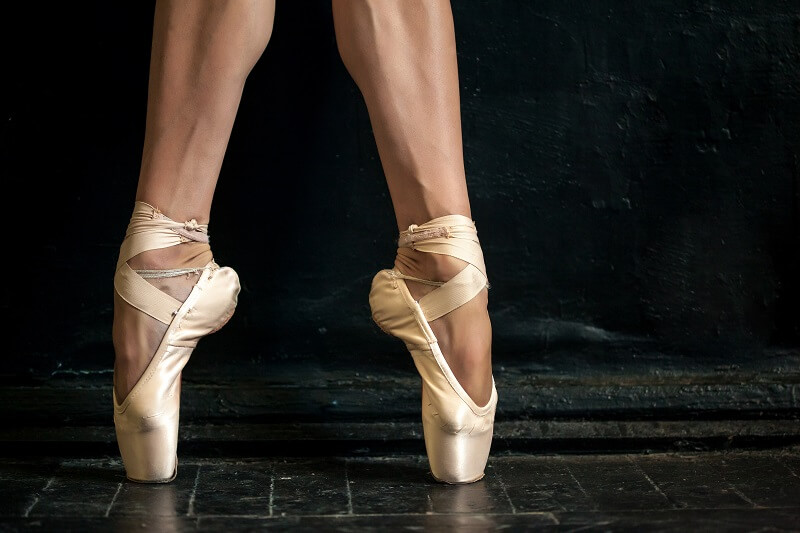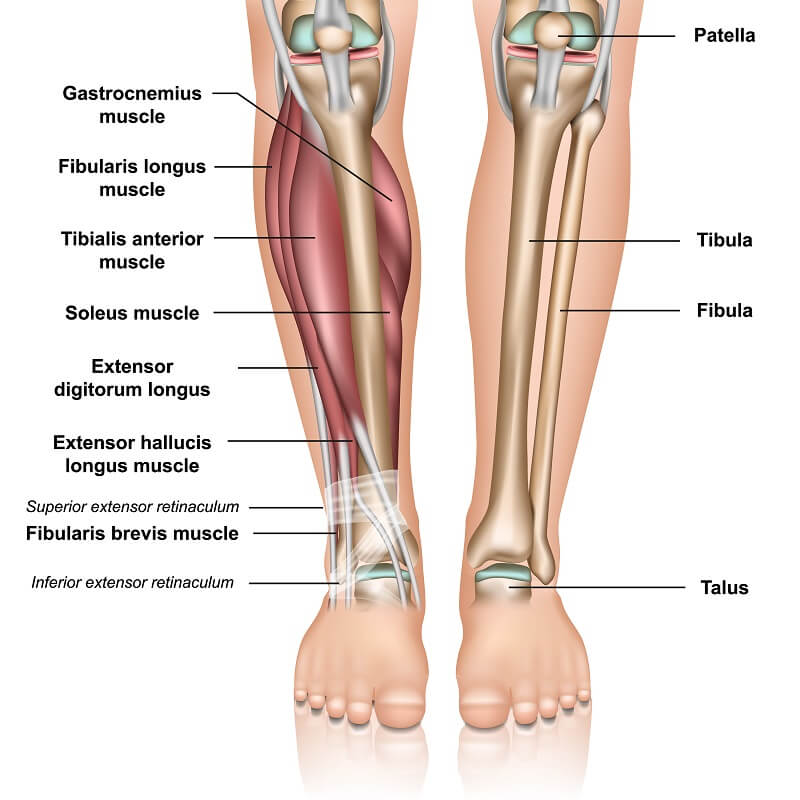Definition
Plantar flexion, sometimes written as ‘plantarflexion,’ is the movement of the top of your foot away from the leg in a downward motion. For example, pointing your feet and standing on the tips of your toes, or are both examples of plantar flexion. You also use plantar flexion to a lesser extent while walking, running, and cycling.
Normally, the range of plantar flexion motion is between a 20-50 degree angle. However, ballet dancers who dance en pointe, have an extreme range of plantar flexion motion that is significantly above the normal range (135% increase!).
Excessive plantar flexion is linked with various injuries and pain in the ankle. However, there are exercises that can be carried out to help strengthen the muscles and alleviate the pain linked to this movement.

Anatomy of the Plantar Flexion Muscles
Plantar flexion is controlled by several muscles in the ankle, foot, and leg. These muscles coordinate with one another to stretch the foot forward.
Triceps Surae
The triceps surae are two muscles that form the major muscles of the calf. These muscles are the gastrocnemius and the soleus, and they insert into the bone of the heel. Where they unite at the lower end of the calf, they form the Achilles tendon.
When the triceps surae contract, they cause plantar flexion. Out of all of the involved muscles, the gastrocnemius does most of the work in the movement. The soleus muscle is responsible for the action of pushing away from the ground, so is also crucial for plantar flexion.
Plantaris Muscle
The plantaris muscle has a short belly and a long, thin tendon that extends behind the knee and into the calf. At the bottom of the calf, it connects directly with the heel bone. It works with the gastrocnemius and the soleus to facilitate plantar flexion. Interestingly, it is often considered vestigial and is absent in one or both legs in around 10% of individuals.

Flexor Muscles
The flexor muscles are the flexor hallucis longus and the flexor digitorum longus. The flexor hallucis longus flexes the joints of the big toe, and the flexor digitorum longus flexes the joints of the rest of the toes. These actions are both important in plantar flexion.
Tibialis Posterior Muscle
The tibialis posterior muscle is located deep within the lower leg and assists with plantar flexion at the ankle. It is also important generally for stabilization of the ankle and leg.
Peroneus Muscles
The peroneus muscles (also called the fibularis muscles) are composed of three separate muscles. These muscles are the peroneus longus (also called the fibularis longus), the peroneus brevis (also called the fibularis brevis), and the peroneus tertius (also called the fibularis tertius).
The peroneus longus and brevis assist with plantar flexion. In contrast, the peroneus tertius facilitates dorsiflexion (i.e., it bends the foot backward).
Plantar Flexion vs Dorsiflexion
Plantar comes from the Latin ‘planta,’ which means sole and refers to the sole of the foot. Flexion comes from the Latin ‘flectere,’ which means to bend, and refers to a movement that decreases the angle between two body parts.
The opposite movement to plantar flexion is dorsiflexion, sometimes written as ‘dorsi flexion.’ This is when the tip of the toe is stretched back closer to the leg. It involves stretching the foot at the ankle and contracting the shin.

Plantar Flexion-Associated Pain and Injury
Problems performing plantar flexion or pain when performing the movement are usually associated with ankle injuries.
Conversely, frequent plantar flexion can also cause ankle problems, such as posterior ankle impingement syndrome. This is commonly referred to as ‘dancer’s heel,’ and is very common in ballet dancers, athletic jumpers, and soccer players. It causes pain during plantar flexion and sometimes requires surgery to correct.
Another injury associated with excessive plantar flexion is os trigonum syndrome. The os trigonum is an accessory bone that sometimes develops behind the ankle but is not present in all individuals. Plantar flexion causes the ankle and heel bones to come together, and with repetition of the movement can cause them to crush the os trigonum. As a result, the tendons and ligaments pull and detach from the bone, causing significant pain, especially when in the foot is in plantar flexion.
Plantar Flexion Contracture
Plantar flexion contracture occurs because the plantar flexion muscles are contracted, causing the ankle joint to have a reduced range of motion. This causes walking and other tasks that require ankle movement to become challenging.
Contracture is especially movement-limiting in severe cases, which frequently occur in individuals with cerebral palsy, or as a result of central nervous system damage or disease.
Exercises and Prevention
In order to prevent problems with plantar flexion or ease contracture, there are various exercises you can do. Some general behavioral changes include limiting the amount of the movement you do day-to-day and adjusting your gait so that you don’t walk on your tiptoes. Instead, you should try to distribute your weight equally across the whole foot. To force this to happen, you can get shoe inserts that are essentially wedges, forcing your heel into an elevated position.
Additionally, stretching exercises that encourage dorsiflexion can help to overcome plantar flexion contracture. You should perform these stretches for at least thirty minutes per day to see a favorable outcome.

Quiz
